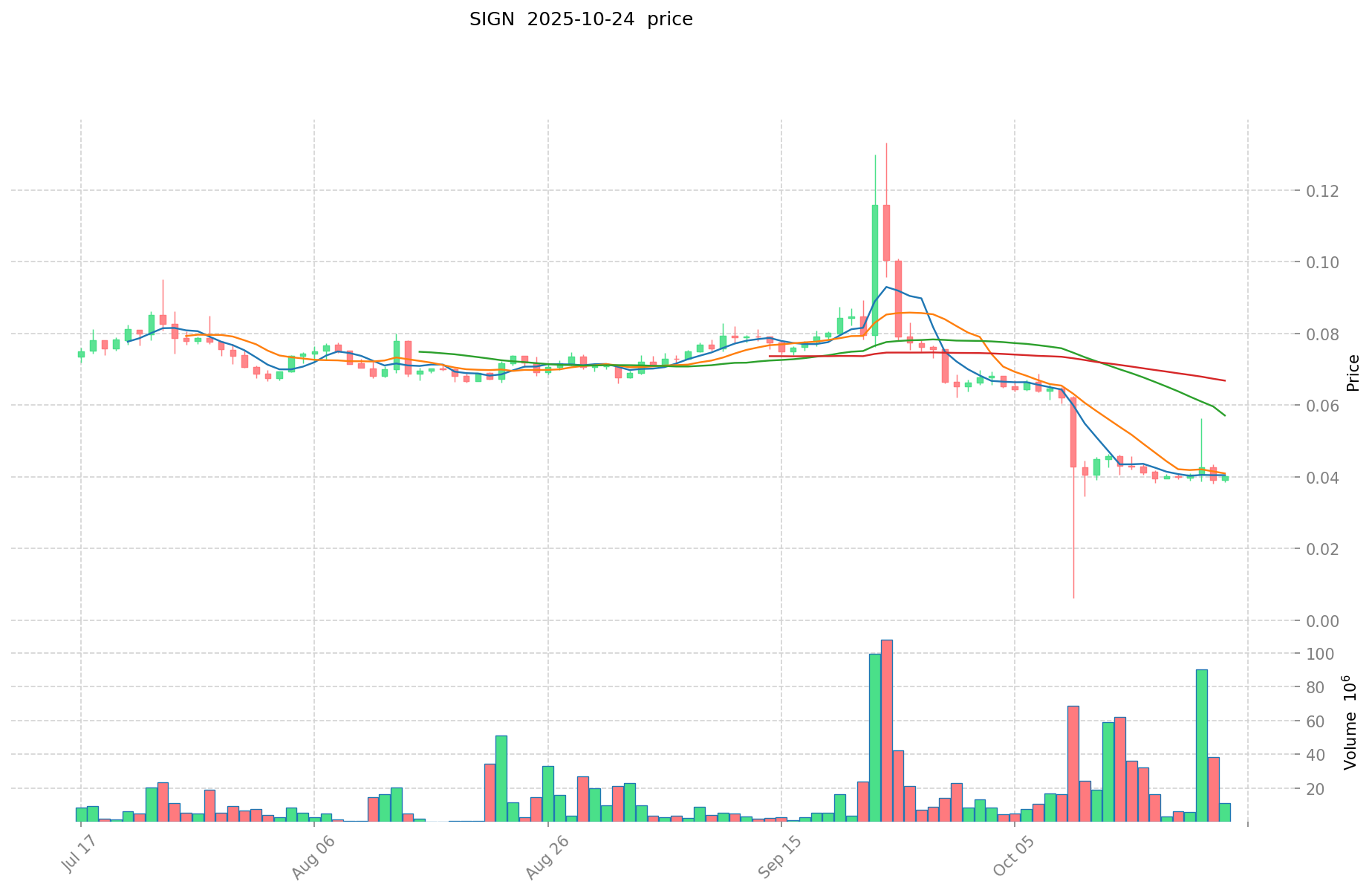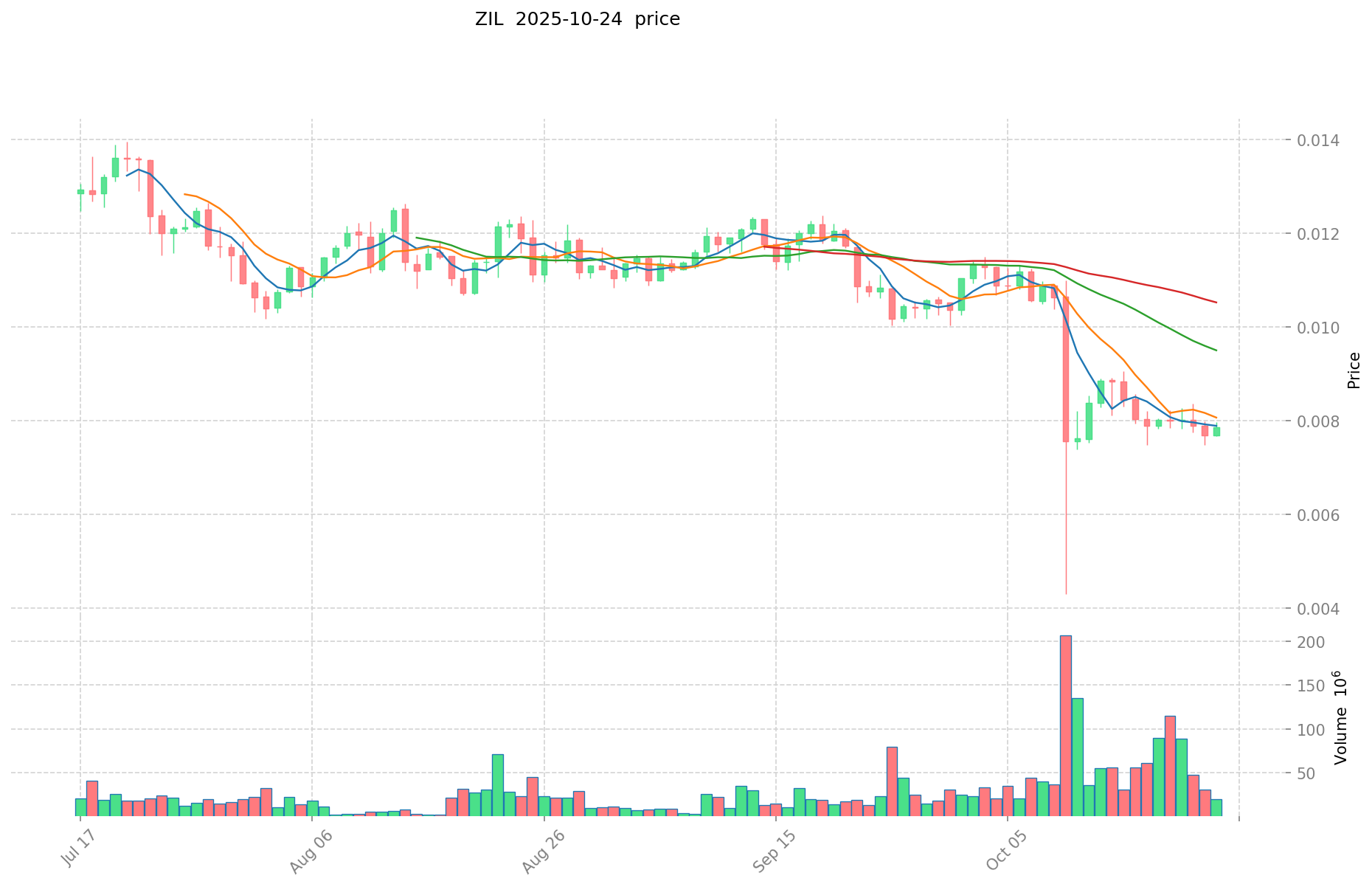SIGN vs ZIL: Comparing Two Blockchain Platforms for Smart Contract Development
Introduction: SIGN vs ZIL Investment Comparison
In the cryptocurrency market, the comparison between SIGN and ZIL has always been a topic that investors can't avoid. The two not only have significant differences in market cap ranking, application scenarios, and price performance, but also represent different positions in crypto assets.
SIGN (SIGN): Since its launch, it has gained market recognition for its global infrastructure for credential verification and token distribution.
ZIL (ZIL): Since 2018, it has been hailed as a high-throughput public blockchain platform, aiming to solve the problems of transaction speed and scalability in current blockchain technology.
This article will comprehensively analyze the investment value comparison between SIGN and ZIL, focusing on historical price trends, supply mechanisms, institutional adoption, technological ecosystems, and future predictions, and attempt to answer the question that investors are most concerned about:
"Which is the better buy right now?"
I. Price History Comparison and Current Market Status
SIGN and ZIL Historical Price Trends
- 2025: SIGN reached an all-time high of $0.14888 on April 29, 2025.
- 2025: ZIL price has declined over the past year, dropping 46.06% in value.
- Comparative analysis: In the recent market cycle, SIGN dropped from its all-time high to a low of $0.00611 on October 10, 2025, while ZIL has shown a similar downward trend.
Current Market Situation (2025-10-24)
- SIGN current price: $0.04026
- ZIL current price: $0.007875
- 24-hour trading volume: SIGN $434,952 vs ZIL $155,940
- Market Sentiment Index (Fear & Greed Index): 27 (Fear)
Click to view real-time prices:
- View SIGN current price Market Price
- View ZIL current price Market Price


Core Factors Influencing SIGN vs ZIL Investment Value
Supply Mechanism Comparison (Tokenomics)
- SIGN: Combines decentralized identity with on-chain verification and cross-chain distribution protocols, enabling over 6 million verifications and $4 billion in token distribution in 2024
- ZIL: Community-supported blockchain ecosystem with focus on technological foundations
- 📌 Historical pattern: Token distribution mechanisms drive community engagement and adoption cycles
Institutional Adoption and Market Applications
- Institutional holdings: SIGN has received $28 million in funding from investors including YZi Labs and Sequoia Capital
- Enterprise adoption: SIGN's TokenTable platform has generated $15 million in revenue in 2024 and processed over $4 billion in token airdrops
- Regulatory attitudes: SIGN is developing infrastructure with potential applications in RWA, CBDC and government collaboration scenarios
Technical Development and Ecosystem Building
- SIGN technical upgrades: Expanding from TokenTable to Sign Protocol - a blockchain authentication verification system designed to solve issues like Sybil attacks while creating programmable trust infrastructure
- ZIL technical development: Focuses on blockchain ecosystem development with community support
- Ecosystem comparison: SIGN offers TokenTable Lite for projects with fewer than 100,000 users and TokenTable Dashboard for transparent on-chain data on token allocation and distribution plans
Macroeconomic Factors and Market Cycles
- Performance in inflationary environments: Both projects rely on community strength and technological foundations
- Monetary policy impacts: Community support appears more predictive of success than traditional professional indicators in Web3 ecosystems
- Geopolitical factors: SIGN's "Orange Dynasty" community of over 50,000 members provides resilient support during market fluctuations
III. 2025-2030 Price Prediction: SIGN vs ZIL
Short-term Prediction (2025)
- SIGN: Conservative $0.0285633 - $0.04023 | Optimistic $0.04023 - $0.0551151
- ZIL: Conservative $0.0070686 - $0.007854 | Optimistic $0.007854 - $0.01162392
Mid-term Prediction (2027)
- SIGN may enter a growth phase, with an estimated price range of $0.0309514030875 - $0.0753345471375
- ZIL may enter a growth phase, with an estimated price range of $0.010767881124 - $0.012897791676
- Key drivers: Institutional capital inflow, ETFs, ecosystem development
Long-term Prediction (2030)
- SIGN: Base scenario $0.075585828585418 - $0.093315837759775 | Optimistic scenario $0.093315837759775 - $0.111045846934132
- ZIL: Base scenario $0.011023430158596 - $0.014504513366574 | Optimistic scenario $0.014504513366574 - $0.015084693901236
Disclaimer: This analysis is based on historical data and market projections. Cryptocurrency markets are highly volatile and unpredictable. This information should not be considered as financial advice. Always conduct your own research before making investment decisions.
SIGN:
| 年份 | 预测最高价 | 预测平均价格 | 预测最低价 | 涨跌幅 |
|---|---|---|---|---|
| 2025 | 0.0551151 | 0.04023 | 0.0285633 | 0 |
| 2026 | 0.0691251975 | 0.04767255 | 0.037184589 | 18 |
| 2027 | 0.0753345471375 | 0.05839887375 | 0.0309514030875 | 45 |
| 2028 | 0.098294064352312 | 0.06686671044375 | 0.035439356535187 | 66 |
| 2029 | 0.104051288121519 | 0.082580387398031 | 0.051199840186779 | 105 |
| 2030 | 0.111045846934132 | 0.093315837759775 | 0.075585828585418 | 131 |
ZIL:
| 年份 | 预测最高价 | 预测平均价格 | 预测最低价 | 涨跌幅 |
|---|---|---|---|---|
| 2025 | 0.01162392 | 0.007854 | 0.0070686 | 0 |
| 2026 | 0.0139267128 | 0.00973896 | 0.0079859472 | 23 |
| 2027 | 0.012897791676 | 0.0118328364 | 0.010767881124 | 50 |
| 2028 | 0.0160749082494 | 0.012365314038 | 0.0117470483361 | 57 |
| 2029 | 0.014788915589448 | 0.0142201111437 | 0.009243072243405 | 80 |
| 2030 | 0.015084693901236 | 0.014504513366574 | 0.011023430158596 | 84 |
IV. Investment Strategy Comparison: SIGN vs ZIL
Long-term vs Short-term Investment Strategies
- SIGN: Suitable for investors focused on digital identity solutions and token distribution ecosystems
- ZIL: Suitable for investors interested in blockchain infrastructure and scalability solutions
Risk Management and Asset Allocation
- Conservative investors: SIGN: 40% vs ZIL: 60%
- Aggressive investors: SIGN: 60% vs ZIL: 40%
- Hedging tools: Stablecoin allocation, options, cross-currency portfolio
V. Potential Risk Comparison
Market Risks
- SIGN: Volatility due to nascent digital identity market
- ZIL: Competition from other blockchain platforms
Technical Risks
- SIGN: Scalability, network stability
- ZIL: Hash power concentration, security vulnerabilities
Regulatory Risks
- Global regulatory policies may impact both differently, with SIGN potentially facing more scrutiny due to its focus on identity verification
VI. Conclusion: Which Is the Better Buy?
📌 Investment Value Summary:
- SIGN advantages: Strong institutional backing, growing adoption in token distribution, potential for government and enterprise applications
- ZIL advantages: Established blockchain ecosystem, focus on scalability and throughput
✅ Investment Advice:
- New investors: Consider a balanced approach with a slight preference for SIGN due to its growing ecosystem
- Experienced investors: Explore opportunities in both, with a focus on SIGN's unique positioning in digital identity
- Institutional investors: Consider SIGN for its potential in enterprise and government applications
⚠️ Risk Warning: Cryptocurrency markets are highly volatile. This article does not constitute investment advice. None
VII. FAQ
Q1: What are the key differences between SIGN and ZIL? A: SIGN focuses on global infrastructure for credential verification and token distribution, while ZIL is a high-throughput public blockchain platform aiming to solve transaction speed and scalability issues.
Q2: Which project has shown better price performance recently? A: SIGN has shown better recent performance, reaching an all-time high of $0.14888 in April 2025, while ZIL has declined by 46.06% in value over the past year.
Q3: How do the supply mechanisms of SIGN and ZIL compare? A: SIGN combines decentralized identity with on-chain verification and cross-chain distribution protocols, enabling millions of verifications and billions in token distribution. ZIL focuses on a community-supported blockchain ecosystem.
Q4: What institutional backing does SIGN have? A: SIGN has received $28 million in funding from investors including YZi Labs and Sequoia Capital.
Q5: How do the long-term price predictions for SIGN and ZIL compare? A: By 2030, SIGN is predicted to reach $0.075585828585418 - $0.111045846934132, while ZIL is expected to reach $0.011023430158596 - $0.015084693901236 in the base to optimistic scenarios.
Q6: What are the main risk factors for each project? A: SIGN faces risks related to market volatility in the nascent digital identity market and potential regulatory scrutiny. ZIL faces competition from other blockchain platforms and risks associated with hash power concentration.
Q7: Which project might be more suitable for institutional investors? A: SIGN might be more suitable for institutional investors due to its potential applications in enterprise and government scenarios, as well as its focus on digital identity solutions.
Share
Content